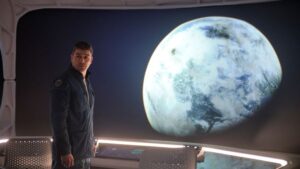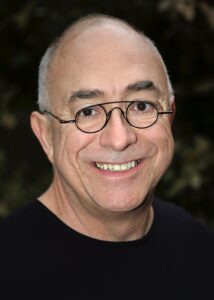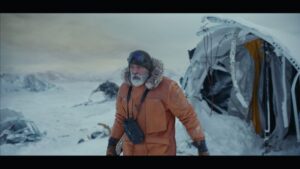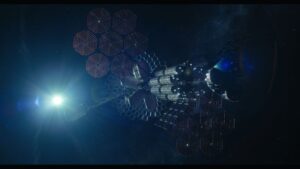
The Midnight Sky, based on the novel Good Morning, Midnight by Lily Brooks-Dalton and directed by George Clooney, follows a scientist Augustine (George Clooney) during a post-apocalyptic era as he is stranded in the Arctic and attempts to signal and warn the astronauts in space about a catastrophe on Earth. Sound plays a major role in The Midnight Sky as veteran Sound Designer/Supervising Sound Editor Randy Thom (The Revenant, How to Train Your Dragon franchise) creatively designed an Arctic landscape, space, and elements of a spacecraft.

The younger Augustine’s voice is modified to match George Clooney’s actual voice. The sound designer detailed, “The most daunting challenge sound wise in the whole movie was not even a sound effect, it was dialogue. George Clooney plays the older Augustine character who we see throughout the film and Ethan Peck plays the young Augustine. The problem is that we wanted the young Augustine to sound credibly, like a young version of George Clooney, and wanted to incorporate Ethan’s performance as well. We can’t really digitally turn a 60-year-old George Clooney into a 25 or 30-year-old George Clooney. We found a way using artificial intelligence and deep learning to meld Ethan Peck’s voice with George Clooney’s voice by studying intricate detail of what exactly makes up those two voices. We can combine the two voices so that it sounds like one person. It doesn’t sound like two people talking at the same time, but the result is that it has some of the characteristics of one voice and some characteristics of the other voice. I hope we succeeded in the sense that when we watch the film, we believe it sounds like a younger George Clooney, but it still does what it needs to do.”
Wind is an essential component in the Arctic sequences. “The number of winds that we had to come up with was pretty amazing because we have lots of different types of scenes out in the snow with wind blowing; wind is almost always present. When we’re doing the sound for it, we try to evoke all the appropriate feelings with the sound effects. We have thousands and thousands of recordings of wind in our library to choose from, many of which have never been in a film before. We’re constantly going on expeditions to record all kinds of sound effects, including wind. Orchestrating the wind was a really fun challenge. Kyrsten Mate, the other sound designer on the movie, did a lot of the wind work in the film and did an amazing job,” Thom highlighted.
The ice breaking sequence presented a unique challenge. “The most challenging sound effects sequence was the icebreaking sequence. We needed to hear a lot of things that we didn’t see. In that sequence with that trailer structure that they’re in, it begins to sink into what is presumably a frozen lake because the ice is breaking all around it. George wanted us to convey this idea that it wasn’t just that specific area, the piece of ice that the trailer was sitting on was breaking, but the ice was beginning to break everywhere around. It was dark enough that we couldn’t really see that happening. One of the challenges of the sequence was to make it sound like that was happening. It was also a big challenge to make the icebreaking as diverse and musical as we could. Sound of icebreaking can just be noise and not have much character. We went to a lot of effort to try to put as much character into the cracking of the ice and the ice in the water as we could,” the supervisor sound editor explained.
Thom continued, “Another interesting thing that we did in terms of sound effects was that I was struggling to find a set of sounds that would suggest that the birds were dying. I certainly tried to find bird vocalizations that sounded like they could be sick birds. It occurred to me that the movement of the birds in the snow could be another element for that. I found that if I added a watery element to the bird’s wing flaps, and they’re struggling, it somehow conveyed a sense of sickness; it makes us feel like we’re hearing the insides of the birds decaying. It makes no logical sense at all because they’re in this subzero environment, so there probably wouldn’t be any actual water. But it does make us feel for those birds even more. I tried it both ways. In a way, it’s like Foley, we didn’t perform it in a Foley sense, but it basically performs the same function as Foley. We tried it with the water element and without the water element with these birds struggling. Definitely, the birds felt more sick when there was this liquid element to their struggling.”
The radio frequency also impacts the sound signal. “The radio communication is another category of sounds that we tried to use in a very musical way in the movie. They’re trying to desperately get in touch with somebody because they haven’t received any communication or any response from anybody over the radio for several weeks. It was important to us and to George that the radio noise itself have a musical aspect, lonely, and isolated sound. We searched for elements of sound, some of them were literally radio recordings that we made of various kinds, shortwave and other radio sounds. We cheated and used some sounds that were not necessarily radios. There’s a dog howling in a very lonely way that is an element in one of the radio transmissions. In those sequences, we’re trying to emphasize how isolated, alone, and lonely they are in that situation, unable to communicate with anyone,” the sound designer signaled.
The Aether spaceship delicately balances the rules and elements of space. The supervising sound editor elaborated, “We wanted to tip our hats to the laws of physics. Sound does not get propagated in space. If we were somehow actually out in space and a bomb went off 10 feet from us, we would not hear it. It is a movie and it is important for sound to evoke what’s going on in the story and with the characters. In Gravity, which George Clooney was also in, they decided to hue pretty close to the laws of physics, such as when we’re out in space we really don’t hear much in terms of sound effects. We decided to not quite go that far. The conceit that we settled on is that when our characters are outside the spaceship, we set it up so what they hear, and what we in the audience hear, is what they would pick up just through what they are touching. If they are grabbing the ship and an asteroid hits the ship, the impression that we wanted the audience to get whether they consciously thought about it or not was that the character and they the audience are hearing mostly very low frequency sounds that would be transmitted through the body of the ship, through their hands, and their arms into their ears. The sound of those asteroids hitting the ship were not very different on the outside of the ship than they were on the inside of the ship. That’s because we’re going with this same idea that it’s the point of view of the astronauts, whether they’re inside or outside. Almost all of those impacts have a muffled aspect to them that supports this idea that it’s the sound being transmitted through their bodies. When we’re inside the spaceship, it’s the point of view of the characters who were there inside the ship and there is air to transmit sound inside the spaceship. They’re hearing the sound muffled because there is this metal or whatever material that makes up the shell of a spaceship that’s muffling the sound.”
A majority of the film incorporates Foley sound effects. “Foley being mainly the sounds of human movement, footsteps, picking up things, putting down things, grabbing things, touching things, and manipulating objects. The biggest challenge in terms of Foley was that movement around the outside of the spaceship because we wanted this muffled effect, that what we’re hearing is that sound transmitted through the astronaut’s bodies. That dictated a certain Foley performance. For instance, when the performer is grasping a piece of metal on the outside of the ship to pull him or herself along on the outside, it has to be grasped harder than normal because if we didn’t do that, it wouldn’t be legible or audible enough when we then muffled the sound, which we do later. We recorded all the Foley then processed it later to give it this muffled effect,” the supervising sound editor accentuated.
The score and music accompany the picture to enhance the emotional connection. Thom praised, “Alexandre Desplat did a wonderful job with the music and it’s some of his best work ever. His task was also very much in part to convey the feeling of isolation and loneliness. When a film composer tries to do that, what they often use is a solo instrument or very few instruments. There’s something about a solo instrument, whether it’s a piano or any other instrument, that tends to convey loneliness. One interesting moment in the film, in terms of whether to use music at all or not, was the sequence where the birds are dying; the Augustine character comes out of the observatory to take readings to see if the air is poisonous. At first, we hear these chirping sounds, we’re not sure what they are as we’re watching Augustine walk out into the snow. Then he and we realize that those sounds are coming from a huge flock of birds that are dying and are lying in the snow in the last throes. Desplat did a great piece of score for that sequence. In the final mix, we decided that the sequence would play better if it almost felt like a documentary. There was something about having the score there that made it a little too much like a fiction movie and not enough like a documentary. We tried dropping the score just for that moment and it seemed to work very well.”
The sound design in The Midnight Sky utilizes artificial intelligence technology that enhances a voice, obeys the laws of space sonically, performs a plethora of Foley sound effects, modifies radio communications, and experiments with a variety of sound effects from wind, ice, and birds. The music heightens the emotion and feelings of isolation and loneliness within the film.
“One of the reasons that George wanted me to work on the movie was because I worked on The Revenant. The obvious similarity with Gravity is the space and how we dealt with those contexts in space sonically. In terms of The Revenant, it’s the tortures of the natural world when we are alone, in a desperate situation, and the weather is our enemy. Those two films, Midnight Sky and The Revenant, certainly have that in common.”
Randy Thom is a two-time Academy Award winner, three-time Cinema Audio Society (CAS) winner, and a nine-time Motion Picture Sound Editors (MPSE) winner with over 20 awards in total.
The Midnight Sky can now be seen streaming on Netflix.
Photos courtesy of Netflix.








